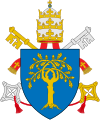Vatican Museums
Coordinates: 41°54′23″N 12°27′16″E / 41.90639°N 12.45444°E
Musei Vaticani | |
 The Vatican Museums as seen from the dome of St. Peter's Basilica | |
 | |
| Established | 1506 |
|---|---|
| Location | |
| Type | Art museum |
| Collection size | 70,000[1] |
| Visitors | 1,300,000 (2020)[2] |
| Director | Barbara Jatta[3] |
| Website | Official website |
| Part of a series on the |
| Vatican Museums |
|---|
 |
|
The Vatican Museums (Italian: Musei Vaticani; Latin: Musea Vaticana) are the public museums of the Vatican City. They display works from the immense collection amassed by the Catholic Church and the papacy throughout the centuries, including several of the most renowned Roman sculptures and most important masterpieces of Renaissance art in the world. The museums contain roughly 70,000 works, of which 20,000 are on display,[1] and currently employ 640 people who work in 40 different administrative, scholarly, and restoration departments.[4]
Pope Julius II founded the museums in the early 16th century.[5] The Sistine Chapel, with its ceiling and altar wall decorated by Michelangelo, and the Stanze di Raffaello (decorated by Raphael) are on the visitor route through the Vatican Museums.
In 2020, due to the COVID-19 pandemic, the Vatican Museums were visited by only 1,300,000 persons, a drop of 81 percent from the number of visitors in 2019, but still enough to rank the museums fourth among the most-visited art museums in the world.[6]
There are 54 galleries, or sale, in total,[citation needed] with the Sistine Chapel, notably, being the last sala within the Museum.
History[]
The Vatican Museums trace their origin to one marble sculpture, purchased in the 16th century: Laocoön and His Sons was discovered on 14 January 1506, in a vineyard near the basilica of Santa Maria Maggiore in Rome. Pope Julius II sent Giuliano da Sangallo and Michelangelo, who were working at the Vatican, to examine the discovery. On their recommendation, the Pope immediately purchased the sculpture from the vineyard owner. The Pope put the sculpture, which represents the Trojan priest Laocoön and his two sons being attacked by giant serpents, on public display at the Vatican exactly one month after its discovery.
Benedict XIV founded the Museum Christianum, and some of the Vatican collections formed the Lateran Museum, which Pius IX founded by decree in 1854.[7]
The museums celebrated their 500th anniversary in October 2006 by permanently opening the excavations of a Vatican Hill necropolis to the public.[8]
On 1 January 2017, Barbara Jatta became the Director of the Vatican Museums, replacing Antonio Paolucci who had been director since 2007.[9][10]
Pinacoteca Vaticana[]

The art gallery was housed in the Borgia Apartment until Pius XI ordered construction of a dedicated building. The new building, designed by Luca Beltrami, was inaugurated on 27 October 1932.[11] The museum's paintings include:
- Giotto: Stefaneschi Triptych
- Olivuccio di Ciccarello: Opere di Misericordia
- Filippo Lippi: Marsuppini Coronation
- Giovanni Bellini: Pietà
- Melozzo da Forlì: Sixtus IV Appointing Platina as Prefect of the Vatican Library
- Pietro Perugino: Decemviri Altarpiece and San Francesco al Prato Resurrection
- Leonardo da Vinci: Saint Jerome in the Wilderness
- Raphael: Madonna of Foligno, Oddi Altarpiece and Transfiguration
- Titian: Frari Madonna
- Antonio da Correggio: Christ in Glory
- Paolo Veronese: The Vision of Saint Helena
- Caravaggio: The Entombment of Christ
- Domenichino, The Last Communion of Saint Jerome
- Nicolas Poussin, The Martyrdom of Saint Erasmus
- Jan Matejko: Sobieski at Vienna
Collection of Modern Religious Art[]
The Collection of Modern Religious Art was added in 1973 and houses paintings and sculptures from such artists as Carlo Carrà, Giorgio de Chirico, Vincent van Gogh, Paul Gauguin, Marc Chagall, Paul Klee, Salvador Dalí, and Pablo Picasso.[12]
Sculpture museums[]
The group of museums includes several sculpture museums surrounding the Cortile del Belvedere. These are the Museo Gregoriano Profano, with classical sculpture, and others as below:
Museo Pio-Clementino[]

The museum takes its name from two popes: Clement XIV, who established the museum, and Pius VI, who brought it to completion. Clement XIV came up with the idea of creating a new museum in Innocent VIII's Belvedere Palace and started the refurbishment work.[15]
Clement XIV founded the Museo Pio-Clementino in 1771; it originally contained artworks of antiquity and the Renaissance. The museum and collection were enlarged by Clement's successor Pius VI. Today, the museum houses works of Greek and Roman sculpture. Some notable galleries are as follows:
- Greek Cross Gallery (Sala a Croce Greca): with the porphyry sarcophagi of Constance and Saint Helena, daughter and mother of Constantine the Great.
- Sala Rotonda: shaped like a miniature Pantheon, the room has impressive ancient mosaics on the floors, and ancient statues lining the perimeter, including a gilded bronze statue of Hercules.
- Gallery of the Statues (Galleria delle Statue): as its name implies, holds various important statues, including Sleeping Ariadne and the bust of Menander. It also contains the Barberini Candelabra.
- Gallery of the Busts (Galleria dei Busti) Many ancient busts are displayed.
- Cabinet of the Masks (Gabinetto delle Maschere). The name comes from the mosaic on the floor of the gallery, found in Villa Adriana, which shows ancient theater masks. Statues are displayed along the walls, including the Three Graces.
- Sala delle Muse: houses the statue group of Apollo and the nine muses, uncovered in a Roman villa near Tivoli in 1774, as well as statues by important ancient Greek or Roman sculptors. The centerpiece is the Belvedere Torso, revered by Michelangelo and other Renaissance men.[16]
- Sala degli Animali: so named because of the many ancient statues of animals.
Museo Chiaramonti[]
This museum was founded in the early 19th century by Pius VII, whose surname before his election as Pope was Chiaramonti. The museum consists of a large arched gallery in which are exhibited several statues, sarcophagi and friezes. The New Wing, or Braccio Nuovo, built by Raffaele Stern, houses statues including the Augustus of Prima Porta, the Doryphoros, and The River Nile. It is in the Neoclassical style and has a wide arched roof with skylights. The colour scheme is blue-grey and white with a polychrome marble floor. The walls of each side of the gallery have a row of large niches in which stand marble statues. Between the niches are plinths supporting smaller portrait sculptures. The Galleria Lapidaria forms part of the Museo Chiaramonti, and contains over 3,000 stone tablets and inscriptions. It is accessible only with special permission, usually for the purpose of academic study.
Museo Gregoriano Etrusco[]
Founded by Gregory XVI in 1837, this museum has nine galleries and houses important Etruscan pieces, coming from archaeological excavations.[17] The pieces include vases, sarcophagus, bronzes and the Guglielmi Collection.
Museo Gregoriano Egiziano[]
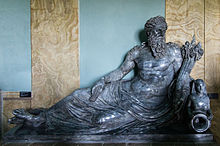
This museum houses a large collection of artifacts from Ancient Egypt.[18] Such material includes papyruses, the Grassi Collection, animal mummies, and reproductions of the Book of the Dead.[19]
The Museo Gregoriano Egiziano was inaugurated on 2 February 1839 to commemorate the anniversary of Gregory XVI's accession to the papacy. The creation of the museum was particularly close to the pope's heart as he believed that the understanding of ancient Egyptian civilization was vital in terms of its scientific importance as well as its value in understanding the Old Testament. This feeling was expressed in a paper by the museum's first curator, the physiologist and Barnabite, Father Luigi Maria Ungarelli.[15]
Vatican Historical Museum[]
The Vatican Historical Museum (Italian: Museo storico vaticano) was founded in 1973 at the behest of Paul VI,[20] and was initially hosted in environments under the Square Garden. In 1987, it moved to the main floor of the Apostolic Palace of the Lateran, where it opened in March 1991.
The Vatican Historical Museum has a unique collection of portraits of the Popes from the 16th century to date, the memorable items of the of the 16th–17th centuries, and old religious paraphernalia related to rituals of the papacy. Also on display on the lower floor are the papamobili (Popemobiles), carriages and motorcars of popes and cardinals, including the first cars used by popes.[21]
Highlights[]
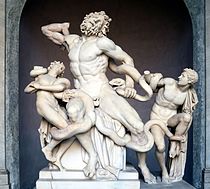
Agesander, Athenodorus and Polydorus
Laocoön and His Sons
Museo Pio-Clementino
Apollonius
Belvedere Torso
Museo Pio-Clementino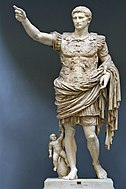
Roman, 1st century AD
Augustus of Prima Porta
Museo Chiaramonti
After Leochares
Apollo Belvedere
Museo Pio-Clementino
Leonardo da Vinci
Saint Jerome in the Wilderness
Pinacoteca Vaticana
Michelangelo
The Creation of Adam
Sistine Chapel (ceiling)
Raphael
The School of Athens
Raphael Rooms
Raphael
The Transfiguration
Pinacoteca Vaticana
Michelangelo
The Last Judgment
Sistine Chapel
Caravaggio
The Entombment of Christ
Pinacoteca VaticanaWalcott Inlet area, Western Australia
Depiction of Wandjina
Anima Mundi

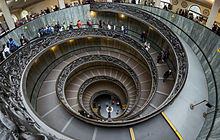
- The red marble papal throne, formerly in the Basilica of Saint John Lateran.
- Roman sculpture, tombstones, and inscriptions, including the Early Christian Sarcophagus of Junius Bassus and Dogmatic sarcophagus, and the epitaph of Lucius Cornelius Scipio Barbatus.
- The Raphael Rooms with many works by Raphael and his workshop, including the masterpiece The School of Athens (1509–1511).
- The Niccoline Chapel.
- The Sistine Chapel, including the Sistine Chapel ceiling (gallery).
- The Gallery of Maps: topographical maps of the whole of Italy, painted on the walls by friar Ignazio Danti of Perugia, commissioned by Gregory XIII (1572–1585). It remains the world's largest pictorial geographical study.
- The frescoes and other works in the Borgia Apartment built for the Borgia pope Alexander VI.
- The Bramante Staircase is a double spiral staircase designed by Giuseppe Momo in 1932. The staircase has two parts, a double helix, and is of shallow incline, being a stepped ramp rather than a true staircase. It encircles the outer wall of a stairwell about fifteen metres (49 feet) wide and with a clear space at the centre. The balustrade around the ramp is of ornately worked metal.
Visitors[]
See also[]
- Accademia, Venice
- Index of Vatican City-related articles
- List of most visited art museums
- Uffizi, Florence
References[]
- ^ Jump up to: a b "Meet Antonio Paolucci". Divento. Archived from the original on 2016-12-29. Retrieved 2016-12-28.
- ^ The Art Newspaper, March 30,2021
- ^ Troszczynska, Katarzyna (1 January 2017). "To ona rządzi w Watykanie. Kim jest Barbara Jatta?" [Who is Barbara Jatta? She is the director of the Vatican] (in Polish). Virtual Poland. Retrieved 2017-08-29.
- ^ Jatta, Barbara (16 October 2016). "The Vatican Museums: transformation of an organisation" (PDF). Vatican Museums. Retrieved 29 August 2017.
- ^ Bianchini, Riccardo (30 August 2017). "Vatican Museums – Rome". Inexhibit. Retrieved 30 August 2017.
- ^ The Art Newspaper visitor survey, March 30, 2021.
- ^ Herbermann, Charles, ed. (1913). . Catholic Encyclopedia. New York: Robert Appleton Company.
- ^ McMahon, Barbara (10 October 2006). "Ancient Roman treasures found under Vatican car park". The Guardian. Manchester. Retrieved 29 August 2017.
- ^ Glatz, Carol (20 December 2016). "Pope names first woman to head Vatican Museums". The Catholic Herald. Retrieved 29 August 2017.
- ^ Rykner, Didier (7 December 2007). "Antonio Paolucci, the new Director of the Vatican Museums". The Art Tribune. Retrieved 28 August 2017.
- ^ "Pinacoteca". Vatican Museums. Retrieved 29 August 2017.
- ^ "The Vatican Museums". Vatican City State. Retrieved 28 August 2017.
- ^ Saddington, D. B. (2011). "Classes: the Evolution of the Roman Imperial Fleets Plate 12.2 on p. 204". In Erdkamp, Paul (ed.). A Companion to the Roman Army. Malden: Wiley-Blackwell. pp. 201–217. ISBN 978-1-4051-2153-8.
- ^ Coarelli, Filippo (1987). I Santuari del Lazio in età repubblicana [The Sanctuaries of Lazio in the Republican age] (in Italian). Carocci. pp. 35–84.
- ^ Jump up to: a b Bertoldi, Susanna (2011). The Vatican Museum: Discover the history, the works of art, the collections. Vatican City: Sillabe. pp. 46, 96. ISBN 978-88-8271-210-5.
- ^ Montebello, Philippe De; Kathleen Howard (1983). "Sala delle Muse". The Vatican: Spirit and Art of Christian Rome. Metropolitan Museum of Art. pp. 178–180. ISBN 978-08-70993480.
- ^ "Museo Gregoriano Etrusco". Vatican Museums. Retrieved 2021-01-05.
- ^ "Gregorian Egyptian Museum". Vatican Museums. Retrieved 2014-08-21.
- ^ "Monuments exhibited in Room II of the Egyptian Museum". Archived from the original on 5 July 2011.
- ^ Guide to the Vatican Museums and City. Musei Vaticani. 1986. ISBN 978-88-86921-11-4. Retrieved 9 May 2013.
- ^ "Museo Storico Vaticano (San Giovanni)". Roma Capitale. Retrieved 28 August 2017.
Further reading[]
- G. Spinola, Il Museo Pio-Clementino (3 vols., 1996, 1999, 2004)
- G. B. Visconti and E. Q. Visconti, Il Museo Pio-Clementino Descritto (8 vols., 1782–1792)
- Daley, John (1982). The Vatican: spirit and art of Christian Rome. New York: The Metropolitan Museum of Art. ISBN 978-0810917118.
- Peter Rohrbacher: Völkerkunde und Afrikanistik für den Papst. Missionsexperten und der Vatikan 1922–1939 in: Römische Historische Mitteilungen 54 (2012), 583–610.
External links[]
| Wikimedia Commons has media related to Vatican Museums. |
- Vatican Museums
- 1506 establishments in the Papal States
- Art museums and galleries in Rome
- Art museums established in 1506
- Museums in Vatican City
- Museums of ancient Greece
- Museums of ancient Rome
- Museums of Dacia
- National museums
- National galleries
- Organizations established in the 1500s
- Vatican City culture
- Double spiral staircases
- Rome Q. XIV Trionfale
- Christian museums














